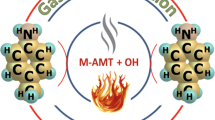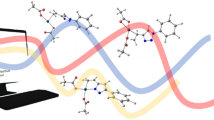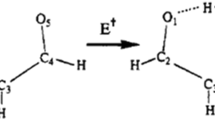Abstract
The Clˉ anion as the halogen bond acceptor, the diiodotetrafluoroethane I(CF2)2I and its derivatives I(MF2)nI (M = C, Si, Ge, Sn) as the halogen bond donor, and the strong halogen bonds could be formed. The halogen bonds between I(MF2)nI and Clˉ have been designed and investigated by Moller–Plesset perturbation/aug-cc-pVDZ calculations together with the aug-cc-pVDZ-pp basis set for iodine and stannum. The halogen bonds in the I(MF2)nI∙∙∙Clˉ complexes are strong, which are apparently related to the group IV elements, becoming stronger along the sequence of M = Si, C, Ge, Sn. Accompanied with increasing number (n) of MF2 unit, the halogen bonds (M = Si, Ge, Sn) also become stronger. The energy decomposition analyses reveal that the exchange energy contributes most in forming these halogen-bonded interactions. In the meantime, the electrostatic energy is also a significant factor for the I∙∙∙Clˉ interactions. The halogen bonds of I(MF2)nI∙∙∙Clˉ(M = C, Ge, Sn) belong to partial-covalent interactions, while they are noncovalent interactions when M = Si.






Similar content being viewed by others
References
Cabot R, Hunter CA (2009) Non-covalent interactions between iodo-perfluorocarbons and hydrogen bond acceptors. Chem Commun 45:2005–2007
Li Q, Li R, Liu Z, Li W, Cheng J (2011) Interplay between halogen bond and lithium bond in MCN-LiCN-XCCH (M = H, Li, and Na; X = Cl, Br, and I) complex: the enhancement of halogen bond by a lithium bond. J Comput Chem 32:3296–3303
Lu Y, Shi T, Wang Y, Yang H, Yan X, Luo X, Jiang H, Zhu W (2009) Halogen bonding—a novel interaction for rational drug design? J Med Chem 52:2854–2862
Metrangolo P, Resnati G (2008) Chemistry. Halogen versus hydrogen Science 321:918–919
Murray JS, Lane P, Clark T, Politzer P (2007) Sigma-hole bonding: molecules containing group VI atoms. J Mol Model 13:1033–1038
Saha BK, Nangia A, Jaskolski M (2005) Crystal engineering with hydrogen bonds and halogen bonds. CrystEngComm 7:355–358
Metrangolo P, Resnati G, Pilati T, Biella S (2008) Halogen bonding in crystal engineering 61:105–136
Auffinge P, Hays FA, Westhof E, Ho PS (2004) Halogen bonds in biological molecules. Proc Natl Acad Sci USA 101: 16789–16794
Parisini E, Metrangolo P, Pilati T, Resnati G, Terraneo G (2011) Halogen bonding in halocarbon–protein complexes: a structural survey. Chem Soc Rev 40:2267–2278
Cavallo G, Metrangolo P, Milani R, Pilati T, Priimagi A, Resnati G, Terraneo G (2016) The Halogen Bond. Chem Rev 116: 2478−2601
Metrangolo P, Pilati T, Resnati G (2006) Halogen bonding and other noncovalent interactions involving halogens: a terminology issue. CrystEngComm 8:946
Clark T, Hennemann M, Murray JS, Politzer P (2007) Halogen bonding: the sigma-hole. J Mol Model 13:291–296
Murray JS, Lane P, Clark T, Riley KE, Politzer P (2012) Sigma-holes, pi-holes and electrostatically-driven interactions. J Mol Model 18:541–548
Politzer P, Murray JS (2017) Sigma-holes and pi-holes: similarities and differences. J Comput Chem DOI: 10.1002/jcc.24891
Murray JS, Macaveiu L, Politzer P (2014) Factors affecting the strengths of σ-hole electrostatic potentials. Journal of Computational Science 5:590–596
Bruce DW, Metrangolo P, Meyer F, Präsang C, Resnati G, Terraneo G, Whitwood AC (2008) Mesogenic, trimeric, halogen-bonded complexes from alkoxystilbazoles and 1,4-diiodotetraflu-orobenzene. New J Chem 32:477–482
Abate A, Saliba M, Hollman DJ, Stranks SD, Wojciechowski K, Avolio R, Grancini G, Petrozza A, Snaith HJ (2014) Supramolecular halogen bond passivation of organic-inorganic halide perovskite solar cells. Nano Lett 14:3247–3254
Kumar V, Mulder DJ, Cavallo G, Pilati T, Terraneo G, Resnati G, Schenning APHJ, Metrangolo P (2017) Structural characterization of new fluorinated mesogens obtained through halogen-bond driven self-assembly. J Fluor Chem 198:54–60
Frisch MJ, Trucks GW, Schlegel HB, Scuseria GE, Robb MA, Cheeseman JR, Scalmani G, Barone V, Mennucci B, Petersson GA, Nakatsuji H, Caricato M, Li X, Hratchian HP, Izmaylov AF, Bloino J, Zheng G, Sonnenberg JL, Hada M, Ehara M, Toyota K, Fukuda R, Hasegawa J, Ishida M, Nakajima T, Honda Y, Kitao O, Nakai H, Vreven T, Montgomery Jr JA, Peralta JE, Ogliaro F, Bearpark M, Heyd JJ, Brothers E, Kudin KN, Staroverov VN, Keith T, Kobayashi R, Normand J, Raghavachari K, Rendell A, Burant JC, Iyengar SS, Tomasi J, Cossi M, Rega N, Millam JM, Klene M, Knox JE, Cross JB, Bakken V, Adamo C, Jaramillo J, Gomperts R, Stratmann RE, Yazyev O, Austin AJ, Cammi R, Pomelli C, Ochterski JW, Martin RL, Morokuma K, Zakrzewski VG, Voth GA, Salvador P, Dannenberg JJ, Dapprich S, Daniels AD, Farkas O, Foresman JB, Ortiz JV, Cioslowski J, Fox DJ (2009) Gaussian 09, Revision A.02. Gaussian, Inc, Wallingford, CT,
Woon DE, Dunning TH (1994) Gaussian basis sets for use in correlated molecular calculations. IV. Calculation of static electrical response properties. J Chem Phys 100:2975–2988
Bene JED (1993) Proton affinities of NH3, H2O, and HF and their anions—a quest for the basis-set limit using. J Phys Chem 97:107–110
Kendall RA, Dunning TH, Harrison RJ (1992) Electron affinities of the first-row atoms revisited. Systematic basis sets and wave functions. J Chem Phys 96:6796–6808
Peterson KA, Figgen D, Goll E, Stoll H, Dolg M (2003) Systematically convergent basis sets with relativistic pseudopotentials. II. Small-core pseudopotentials and correlation consistent basis sets for the post-d group 16–18 elements. J Chem Phys 119, 11099–11112
Boys SF, Bernardi F (1970) The calculation of small molecular interactions by the differences of separate total energies. Some procedures with reduced errors. Mol Phys 19:553–566
Murray JS, Lane P, Politzer P (2007) A predicted new type of directional noncovalent interaction. Int J Quantum Chem 107:2286–2292
Zeng Y, Zhu M, Li X, Zheng S, Meng L (2012). J Comput Chem 33:1321–1327
Politzer P, Truhlar DG (1981) Chemical applications of atomic and molecular electrostatic potentials. Plenum
Politzer P, Laurence PR, Jayasuriya K (1985) Molecular electrostatic potentials: an effective tool for the elucidation of biochemical phenomena. Environ Health Perspect 61:191–202
Bulat FA, Toro-Labbe A, Brinck T, Murray JS, Politzer P (2010) Quantitative analysis of molecular surfaces: areas, volumes, electrostatic potentials and average local ionization energies. J Mol Model 16:1679–1691
Su P, Li H (2009) Energy decomposition analysis of covalent bonds and intermolecular interactions. J Chem Phys 131:191–206
Schmidt MW, Baldridge KK, Boatz JA, Elbert ST, Gordon MS, Jensen JH, Koseki S, Matsunaga N, Nguyen KA, Su S, Windus TL, Dupuis M, Montgomery JA (1993) General atomic and molecular electronic structure system. J Comput Chem 14:1347–1363
Lu T, Chen F (2012) Multiwfn: a multifunctional wavefunction analyzer. J Comput Chem 33:580–592
Bader RFW (1990) Atoms in Molecules-A Quantum TheoryOxford University Press: Oxford
Keith TA (2015) AIMAll (Version 15.09.27)
Weinhold F, Landis CR (2005) Valency and bonding: a natural bond orbital donor-acceptor perspective. Cambridge University Press
Glendening ED, Landis CR, Weinhold F (2013) NBO 6.0: Natural Bond Orbital Analysis Program. J Comput Chem 34: 1429–1437
Bundhun A, Ramasami P, Murray JS, Politzer P (2013) Trends in sigma-hole strengths and interactions of F3MX molecules (M = C, Si, Ge and X = F, Cl, Br, I). J Mol Model 19:2739–2746
Lu B, Zhang X, Meng L, Zeng Y (2016) The Pt (II)···Cl Interactions: Nature and Strength. ChemistrySelect 1:5698–5705
Reed AE, Curtiss LA, Weinhold F(1988) Intermolecular interactions from a natural bond orbital, donor-acceptor viewpoint. Chem Rev 88: 899–926
Müller-Dethlefs K, Hobza P (2000) Noncovalent interactions: a challenge for experiment and theory. Chem Rev 100:143–167
Lapointe SM, Farrag S, Bohorquez HJ, Boyd RJ (2009) QTAIM study of an alpha-helix hydrogen bond network. J Phys Chem B 113:10957–10964
Grabowski SJ (2011) What is the covalency of hydrogen bonding? Chem Rev 111:2597–2625
Popelier PLA (2000) Atoms in molecules: an introduction[M]. Prentice Hall, London,
Li W, Zeng Y, Li X, Sun Z, Meng L (2015) The competition of Y···O and X···N halogen bonds to enhance the group V sigma-hole interaction in the NCY···O=PH3···NCX and O=PH3···NCX···NCY (X, Y=F, Cl, and Br) complexes. J Comput Chem 36:1349–1358
Jenkins S, Morrison I (2000) The chemical character of the intermolecular bonds of seven phases of ice as revealed by ab initio calculation of electron densities. Chem Phys Lett 317:97–102
Firme CL, Antunes OAC, Esteves PM (2009) Relation between bond order and delocalization index of QTAIM. Chem Phys Lett 468:129–133
Daudel R (1952) Remarque sur la rôle de l'indiscernabilité des électrons enchimie théorique. Compt Rend Acad Sci 235:886–888
Roux M, Daudel R (1955) Effet de la liaison chimique sur la densité electronique.Cas de la molécule Li2. Compt Rend Acad Sci 240:90–92
Roux M, Besnainou S, Daudel R (1956) Recherches sur la répartition de la densité. J Chem Phys 53:218–221
Li W, Zeng Y, Zhang X, Zheng S, Meng L (2014) The enhancing effects of group V sigma-hole interactions on the F···O halogen bond. Phys Chem Chem Phys 16:19282–19289
Zheng SJ, Hada M, Nakatsuji H (1996) Topology of density difference and force analysis. Theor Chim Acta 93:67–78
Li X, Zeng Y, Zhang X, Zheng S, Meng L (2011) Insight into the lithium/hydrogen bonding in (CH2)2X···LiY/HY (X: C=CH2, O, S; Y=F, Cl, Br) complexes. J Mol Model 17:757–767
Politzer P, Riley KE, Bulat FA, Murray JS (2012) Perspectives on halogen bonding and other σ-hole interactions: Lex parsimoniae (Occam’s Razor). Computational & Theoretical Chemistry 998:2–8
Politzer P, Murray JS, Clark T (2015) Mathematical modeling and physical reality in noncovalent interactions. J Mol Model 21:52
Acknowledgements
This project was supported by the National Natural Science Foundation of China (Contract Nos: 21371045, 21373075), and the Natural Science Foundation of Hebei Province (Contract Nos: B2015205045, B2015205210). Thanks are also due to the Education Department of Hebei Province of China through innovative hundred talents support program (SLRC2017041).
Author information
Authors and Affiliations
Corresponding author
Ethics declarations
The manuscript has full control of all primary data, and the authors agree to allow the journal to review their data if requested.
Competing interest
The authors declare that they have no competing interest.
Rights and permissions
About this article
Cite this article
Wang, J., Sun, Z., Meng, L. et al. Clˉ as the halogen bond acceptor: studies on strong halogen bonds. Struct Chem 29, 503–511 (2018). https://doi.org/10.1007/s11224-017-1047-3
Received:
Accepted:
Published:
Issue Date:
DOI: https://doi.org/10.1007/s11224-017-1047-3




